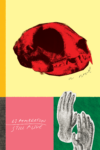The following is an excerpt from A Cool Customer by Jacob Bacharah (Fiction Advocate, 2017), published with permission of Fiction Advocate.
 One of the weirder things about the death of a close loved one is the expectation that the immediate bereaved become biographers and correspondents. Maybe this is a holdover from the lost public death that Ariès reflects on; because the friends, neighbors, acquaintances, colleagues, distant relatives are not literally in the room when the person dies, there is some obligation for those who were, or who nearly were, to describe the death so that the others can imagine they were there too. But is the eyewitness really the most suited to the job? Didion gets quickly to the heart of it:
One of the weirder things about the death of a close loved one is the expectation that the immediate bereaved become biographers and correspondents. Maybe this is a holdover from the lost public death that Ariès reflects on; because the friends, neighbors, acquaintances, colleagues, distant relatives are not literally in the room when the person dies, there is some obligation for those who were, or who nearly were, to describe the death so that the others can imagine they were there too. But is the eyewitness really the most suited to the job? Didion gets quickly to the heart of it:
“And then—gone.” In the midst of life we are in death, Episcopalians say at the graveside. Later I realized that I must have repeated the details of what happened to everyone who came to the house in those first weeks, all those friends and relatives who brought food and made drinks and laid out plates on the dining room table for however many people were around at lunch or dinner time, all those who picked up the plates and froze the leftovers and ran the dishwasher and filled our (I could not yet think my) other-wise empty house even after I had gone into the bedroom (our bedroom, the one in which there still lay on a sofa a faded terrycloth XL robe bought in the 1970s at Richard Carroll in Beverly Hills) and shut the door. Those moments when I was abruptly overtaken by exhaustion are what I remember most clearly about the first days and weeks. I have no memory of telling anyone the details, but I must have done so, because everyone seemed to know them. At one point I considered the possibility that they had picked up the details of the story from one another, but immediately rejected it: the story they had was in each instance too accurate to have been passed from hand to hand. It had come from me.
On the next page, she reflects, however, on her problem putting the story together. She had failed in her initial attempt to explain what had happened to their housekeeper, José, who had to clean the blood from where Dunne had fallen after his heart attack. The syringes and other detritus of the EMTs Didion could handle herself, but not the blood. “When I first told him what had happened he had not understood,” she writes. “Clearly I was not the ideal teller of this story, something about my version had been at once too offhand and too elliptical, something in my tone had failed to convey the central fact of the situation.”
“The way I write is who I am, or have become,” Didion reflects, quietly echoing something long held as the principal criticism of her writing—that it, and she, are all style. And yet she wishes she had “instead of words and rhythms a cutting room.” She needs “more than words to find the meaning.” She wants “whatever it is I think or believe to be penetrable.”
In an interview with Hilton Als in the Paris Review, several years after The Year of Magical Thinking was published, during a period when she was adapting it as a one-woman play, Didion says of her political writing, “If I am sufficiently interested in a political situation to write a piece about it, I generally have a point of view, although I don’t usually recognize it. Something about a situation will bother me, so I will write a piece to find out what it is that bothers me.”
It strikes me that, while “bothers me” may be an unduly anodyne way to describe the grief you feel when a spouse of forty years dies and your grown but still young child is in and out of critical care for a series of mysterious and complex illnesses, it is nevertheless a pretty neat description of how The Year of Magical Thinking introduces itself and its methods. We enter the book not at the moment of Dunne’s death, though we get there within a few pages, but rather, at the moment that Didion began to write it, a precise date looking back at a precisely timestamped file, neither of them the actual event itself.
And even in the second chapter, in the middle of describing in greater and more obviously journalistic narrative detail the moment when Dunne, just before dinner, slumped to the table and then fell dead to the floor, the victim of a “cardiac event” (as I’ve heard doctors refer to these things when they’re not yet sure which cardiac event, precisely, it is), there remains a certain futility, a kind of impotence, in the attempt to put it into words. “When the paramedics came I tried to tell them what happened,” she writes, but they brush her aside and set about doing what paramedics do. Of course, on the most obvious and practical level, this has nothing to do with the inadequacy of Didion’s attempts to narrate the story. On a practical level, these are just professionals rushing past to get to work as quickly as possible in a critical and acute medical emergency. But there is yet the sense that another part of the problem is in the telling. “Life changes fast” is the first line of the book. And a book is a long, slow thing. So how is a writer to render on a page the way the brief moments of crisis expand and the way the long recoveries afterward collapse in on themselves?
*
On the other hand, The Year of Magical Thinking is very much a corrective to the contemporary view of death as a kind of catastrophe, as a crisis. A note I made to myself in the margins of page 188 of my paperback copy, the first page of chapter seventeen: “A function of its particularity, maybe—except as a whole book—can it really be described—explained.” I didn’t use a question mark. I am slightly embarrassed, actually, of my marginalia, which, when I go back to it, has an uncanny similarity to the slightly batty social-media eructations of Joyce Carol Oates. But I do think there’s a point lurking in there, however silly the phrasing. “Grief turns out to be a place none of us know until we reach it” is the first sentence on the page.
I remember being immediately thunderstruck when I read Jonathan Yardley’s Washington Post review of The Year of Magical Thinking, which declares in the second paragraph that “[i]t is an intensely personal story that involves a relatively small cast of characters, but Didion’s telling of it is clearly impelled in large measure by the events in New York of September 2001.”
It struck me as wrong on a couple of levels. First: it is full of characters, though many of them flash by. In one passage in chapter five, at Didion and Dunne’s wedding, we encounter Didion’s mother, Dunne’s brothers, his brother’s wife Lenny and their four-year-old daughter, a gaggle of Didion’s other close and distant family, Dunne’s Princeton roommate, Quintana’s cousins, her husband Gerry, some of his family, Otto Preminger, Barry Farrell and his wife Marcia, Katharine Ross, Conrad Ross, Jean and Brian Moore, Conrad’s sister Nancy, and Earl McGrath. Elsewhere in the book are doctors—like the young doctor who calls Didion a “cool customer” at the hospital—and social workers and paramedics and pilots, agents and editors, old friends and acquaintances. On and on. Now you might argue that these are not really characters, that those named and unnamed people that flash by in chapter five are closer to setting than character.
You wouldn’t be wrong, exactly, but I am looking at another note I made in the margins. “Your Aunt Marty,” it says. I’m talking about my Aunt Marty, although I could be talking about most of my aunts and uncles and certainly my grandmother Lena, who all have a habit of telling stories peopled with characters from the extended family or from the couple of streets in the neighborhood of Point Breeze, in Pittsburgh, where most of them have lived for the better part of five decades. The thing to mention here is that because my father’s work had moved us when my brother and I were just kids to a couple of other towns outside of the city, neither we nor my mother knew most of these people, or, if we did, we only vaguely recognized a first name or a nickname—often from some other story. It isn’t exclusionary or deliberately obscure to mention these first names or nicknames in passing as part of ordinary conversation in a large but close family whose conversations often consist of a kind of rambling storytelling. On the contrary, it’s a signal of intimacy. It is an assumption of shared experience. It represents a taking into confidence. Didion has occasionally been accused of name-dropping: people, stores, hotels, restaurants. It is sometimes taken as a careless class marker and a further indication of a woman whose writing is more texture and surface than depth, but I find that the habit—and it is a habit in her writing—is instead a mark of familiarity, a way of bringing a reader into the writer’s close circle, even if you’re not sure, exactly, who or what or where some of these people or hotels or restaurants are.
The sillier idea in that Yardley quotation, however, is the idea that Magical Thinking was impelled by the “events in New York of September 2001.” This is, first of all, a remarkably affected locution. By 2005, when the book appeared and the review was written, “9/11” was well settled in the common lexicon as the proper name for those “events in New York.” More pointedly, it widely misses its critical target, which, over two hundred odd pages, seeks among other things to dispel any notion of death, of grief, as a set of fixed rituals and generic, universal meanings. “We do not look beyond the few days or weeks that follow such an imagined death.” “We do not expect to be literally crazy.”
In fact, the topic of literal craziness is central to another contemporaneous Didion work, which is her lecture-turned-essay “Fixed Opinions, or The Hinge of History,” on the eponymous fixed opinions of America after 9/11. In it, she specifically indicts the permanent political class for hijacking the dislocation of national mourning to long-simmering and frankly nefarious ends. If, in any case, The Year of Magical Thinking returns recursively to the scene of John Dunne’s death and the scene (scenes, really) of an unconscious Quintana’s hospital bedside, then it is not in order to fondle the “events,” but rather to drive home the endless outward ripple of these small pebbles on the wider water.
In the version of grief we imagine, the model will be “healing.” A certain forward movement will prevail. The worst days will be the earliest days. We imagine that the moment to most severely test us will be the funeral, after which this hypothetical healing will take place. When we anticipate the funeral we wonder about failing to “get through it,” rise to the occasion, exhibit the “strength” that invariably gets mentioned as the correct response to death. We anticipate needing to steel ourselves for the moment: will I be able to greet people, will I be able to leave the scene, will I be able even to get dressed that day? We have no way of knowing that this will not be the issue. We have no way of knowing that the funeral itself will be anodyne, a kind of narcotic regression in which we are wrapped in the care of others and the gravity and meaning of the occasion. Nor can we know ahead of the fact (and here lies the heart of the difference between grief as we imagine it and grief as it is) the unending absence that follows, the void, the very opposite of meaning, the relentless succession of moments during which we will confront the experience of meaninglessness itself.
What we imagine to be an event, a moment, turns out to be something closer to duration, to a condition. In that way, it recalls the question of character versus setting above; it calls for a kind of description without narrative. “We tell ourselves stories in order to live,” Didion wrote, probably her most famous single line, the line that became the title of her collected non-fiction prior to Magical Thinking. It’s hard not to find your eye lingering a little more on the word stories. It’s hard not to feel a knot at the word live.
Jacob Bacharach is the author of The Bend of the World and The Doorposts of Your House and on Your Gates. His writing has appeared in The New Republic and the Pittsburgh Post-Gazette. He lives in Pittsburgh, Pennsylvania.
This post may contain affiliate links.







